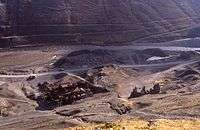Metal mining in Wales
Metal mining in Wales affected large areas of what are now very rural parts of Wales and left behind a legacy of contaminated waste heaps and a very few ruined buildings.
There are a number of areas that have been mined for a variety of metals.
Lead and silver

The principal areas were centred on the upland areas of the River Ystwyth and River Rheidol with some outliers to the east in the catchment of the River Severn and some to the south in the headwaters of the River Teifi. The largest of these mines were the Cwmystwyth and Rheidol United mines in Cwm Rheidol. The ore extracted was Galena which in many cases had a high silver content, especially at Cwm Ystwyth. It also occurred alongside large quantities of sphalerite, the principal ore of Zinc. However, the zinc was only occasionally processed and much remains on the very extensive discard heaps around the mines.
Amongst the very many mines that have existed the following list identifies those known to have existed between the 17th and 19th centuries in north Cardiganshire and west Montgomeryshire:
Aberffrwd, Alma, Blaenceunant, Blaencwmsymlog, Bron floyd, Bryn Glas, Bwa Drain, Bwlch, Cwm Mawr, Cwmystwyth, Cwm Ystwyth South, Cwm Ystwyth West, Cwmbryno, Cwmdarren, Cwmsymlog, De Broke, Dyffryn Castell, Elgar, Esgair Lle, Esgairmwyn, Fron Goch, Fron Goch East, Gelli, Glog fach, Glog Fawr, Goginan, Goginan west, Graig Goch, Grogwynion, Gwaith coch, Lisburne South, Llwynmalus, Logau Las, Melindwr, Mynyddgorddu, Nanteos, Pen Rhiw, Powell, Rheidol United, Temple, Ystumtuen
Metal mining in the Gwydir Forest dates back to the 17th century, but its heyday came in the latter half of the 19th century. These mines predominantly produced lead and zinc, and the last mine to close – Park Mine – closed in the 1960s.[1]
Smaller areas of lead exploitation included Halkyn Mountain in Flintshire and in the Clyne valley in west Swansea.
Arsenic
Although Arsenic is not a metal it has been mined in association with metals and in Wales commercial extraction has probably only occurred in the Clyne valley near Swansea
Copper
Copper mining is probably the oldest known mining activity in Wales with documented evidence of bronze age mining on the Great Orme near Llandudno and at Copa Hill in the valley of the River Ystwyth in Ceredigion. Further copper discoveries were exploited in Snowdonia just to the east of Beddgelert where the Sygun Copper Mine, within the Snowdonia National Park, gives an idea of the conditions faced by copper miners and is a popular tourist attraction. In the 18th centuries the massive deposits of copper together with a range of other metals was discovered and exploited at Parys Mountain on Anglesey.
Gold
Gold was mined as early as the Roman occupation at Dolaucothi in Carmarthenshire and possibly elsewhere. In the 19th century gold was being extracted from a number of small mines at the southern end of Snowdonia with most activity centred in the valley of the River Mawddach and its tributaries.
Iron
Commercial iron ore exploitation has been relatively uncommon in Wales during the last hundred years, despite the dominance of the iron and steel industry in South Wales. However ironstone is a component of the Lower Coal Measures rock sequence and where it outcrops along the northern edge of the South Wales Coalfield, it was extensively worked for the production of iron and was important in the initiation of the Industrial Revolution in South Wales.[2] Commercial exploitation also took place in the Vale of Glamorgan. The Forest of Dean was an important source of iron for many centuries, and dates from at least the Roman period.
Lead
Lead ore was first mined in North Wales during Roman times at Pentre Halkyn to be smelted at Flint. The lead that was produced there was stamped with the inscription Deceangli, which was the name of the Celtic tribe occupying the area. In the 17th century an intensive period of Welsh lead mining commenced, bringing a large number of miners from Derbyshire into Wales. There are substantial reserves of the metal in Cardiganshire, probably first exploited in the Roman period, and extensively during the revival of metal mining in the reign of Queen Elizabeth I.
See also
References
- ↑ mindat.org
- ↑ http://www.visitblaenavon.co.uk/en/WorldHeritageSite/TheBlaenavonStory/BlaenavonIronworks.aspx Blaenavon Ironworks information
External links
- AditNow – Photographic database of mines
- Welsh Mines Society – Society with a focus on the research, recording and exploration of the metal mines of Wales